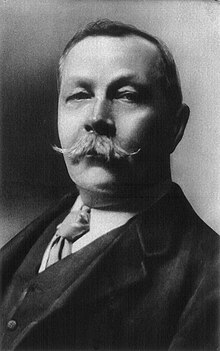About the Book: "The Adventure of the Three Students", one of the 56 Sherlock Holmes short stories written by the British author Sir Arthur Conan Doyle, is one of 13 stories in the cycle collected as The Return of Sherlock Holmes.
About the Author: Arthur Ignatius Conan Doyle was born on 22 May 1859 at 11 Picardy Place, Edinburgh, Scotland. From 1876 to 1881, he studied medicine at the University of Edinburgh, including a period working in the town of Aston (now a district of Birmingham) and in Sheffield, as well as in Shropshire at Ruyton-XI-Towns. While studying, Doyle began writing short stories. His earliest extant fiction, "The Haunted Grange of Goresthorpe", was unsuccessfully submitted to Blackwood's Magazine. His first published piece "The Mystery of Sasassa Valley", a story set in South Africa, was printed in Chambers's Edinburgh Journal on 6 September 1879. On 20 September 1879, he published his first non-fiction article, "Gelsemium as a Poison" in the British Medical Journal. In 1882 he joined former classmate George Turnavine Budd as his partner at a medical practice in Plymouth, but their relationship proved difficult, and Doyle soon left to set up an independent practice. Arriving in Portsmouth in June of that year with less than £10 (£900 today) to his name, he set up a medical practice at 1 Bush Villas in Elm Grove, Southsea. The practice was initially not very successful. While waiting for patients, Doyle again began writing stories and composed his first novels, The Mystery of Cloomber, not published until 1888, and the unfinished Narrative of John Smith, which would go unpublished until 2011. He amassed a portfolio of short stories including "The Captain of the Pole-Star" and "J. Habakuk Jephson's Statement", both inspired by Doyle's time at sea, the latter of which popularized the mystery of the Mary Celeste and added fictional details such as the perfect condition of the ship (which had actually taken on water by the time it was discovered) and its boats remaining on board (the one boat was in fact missing) that have come to dominate popular accounts of the incident. Doyle struggled to find a publisher for his work. His first significant piece, A Study in Scarlet, was taken by Ward Lock Co. on 20 November 1886, giving Doyle £25 for all rights to the story. The piece appeared later that year in the Beeton's Christmas Annual and received good reviews in The Scotsman and the Glasgow Herald. The story featured the first appearance of Watson and Sherlock Holmes, partially modeled after his former university teacher Joseph Bell. Doyle wrote to him, "It is most certainly to you that I owe Sherlock Holmes ... Round the center of deduction and inference and observation which I have heard you inculcate I have tried to build up a man." Robert Louis Stevenson was able, even in faraway Samoa, to recognize the strong similarity between Joseph Bell and Sherlock Holmes: "My compliments on your very ingenious and very interesting adventures of Sherlock Holmes. ... Can this be my old friend Joe Bell?" Other authors sometimes suggest additional influences—for instance, the famous Edgar Allan Poe character C. Auguste Dupin. A sequel to A Study in Scarlet was commissioned and The Sign of the Four appeared in Lippincott's Magazine in February 1890, under agreement with the Ward Lock company. Doyle felt grievously exploited by Ward Lock as an author new to the publishing world and he left them. Short stories featuring Sherlock Holmes were published in the Strand Magazine. Doyle first began to write for the 'Strand' from his home at 2 Upper Wimpole Street, now marked by a memorial plaque. In this period, however, Holmes was not his sole subject and in 1893, he collaborated with J.M. Barrie on the libretto of Jane Annie. Doyle was found clutching his chest in the hall of Windlesham Manor, his house in Crowborough, East Sussex, on 7 July 1930. He died of a heart attack at the age of 71. His last words were directed toward his wife: "You are wonderful." At the time of his death, there was some controversy concerning his burial place, as he was avowedly not a Christian, considering himself a Spiritualist. He was first buried on 11 July 1930 in Windlesham rose garden. He was later re-interred together with his wife in Minstead churchyard in the New Forest, Hampshire. Carved wooden tablets to his memory and to the memory of his wife are held privately and are inaccessible to the public. That inscription reads, "Blade straight / Steel true / Arthur Conan Doyle / Born May 22nd 1859 / Passed On 7th July 1930." The epitaph on his gravestone in the churchyard reads, in part: "Steel true/Blade straight/Arthur Conan Doyle/Knight/Patriot, Physician, and man of letters". Undershaw, the home near Hindhead, Haslemere, south of London, that Doyle had built and lived in between October 1897 and September 1907, was a hotel and restaurant from 1924 until 2004. It was then bought by a developer and stood empty while conservationists and Doyle fans fought to preserve it. In 2012 the High Court ruled that the redevelopment permission be quashed because proper procedure had not been followed. A statue honors Doyle at Crowborough Cross in Crowborough, where he lived for 23 years. There is also a statue of Sherlock Holmes in Picardy Place, Edinburgh, close to the house where Doyle was born.
My Review: In this story, Sherlock Holmes finds himself in a famous university town (probably either Oxford or Cambridge) when a tutor and lecturer of St Luke's College, Mr. Hilton Soames, brings him an interesting problem. Someone had been into Soames’s office and looked at the galley proofs of an exam he was going to give. Soames had gone to a friend’s for tea and locked his office. When he came back an hour later, he found a key in the lock. His servant, Bannister, forgot his key after he found Soames was gone for tea. Nevertheless, the proofs were found out of place, with one near the window, another on the floor, and the last still on the desk. Bannister swears that he did not touch the papers. Interestingly, Holmes can tell Soames which of the papers was in which place.
Soames’s desire is to uncover the cheater and prevent him from taking the exam, since it is for a sizeable scholarship. Fortunately there are only three students who will take the exam, all of which live above him in the same building.
Soames found other clues in his office: pencil shavings, a broken pencil lead, a clean, new cut in his new desk surface about three inches (7.5 cm) long, and a small hollow pyramidal blob of black clay speckled with sawdust. He could find no footmarks or other physical evidence.
Daulat Ras, one of the three students, had been to see Soames while the proofs were on his desk, but as far as Soames can recall, they were rolled up and likely would not have been recognizable as such. At Holmes' request,. Soames gives a brief outline of each of the three students. The first, Giles Gilchrist, is an athletic industrious scholar (in contrast to his father who squandered his fortune in horse racing); the second, Ras, is described as quiet and methodical; the third is Miles McLaren, a gifted man but thoroughly dissolute and given to gambling.
Holmes examines the office window from outside, standing on tiptoes to look in. Inside, there are no clues in the carpet. The cheater obviously took the papers over to the window one by one so that he could see Soames returning, but as it happens, he did not come back the usual way. When Soames came in, he was not aware of any hurried footsteps.
Holmes examines the blob of clay, and pays particular attention to the cut in the desk. This then leads him to ask where a nearby door leads. It is Soames’s bedroom. Upon examining that, Holmes finds another, similar, sawdust-speckled blob of clay. Then, he stuns Soames by telling him that the cheater, upon hearing his approach, hid in Soames’s bedroom. He was there, hiding behind a curtain, all the time that Soames was questioning Bannister.
Holmes questions Bannister and is apparently interested in the fact that anyone in the room could have got out after having entered with the key. He also asks Bannister why he sat several chairs away when he suddenly felt unwell at what had happened. Bannister will not venture a hypothesis as to a suspect.
Holmes decides to call on all three students. In Gilchrist’s room on the first floor, and Ras’s room on the second, Holmes cleverly contrives a ruse which will make it necessary for him to borrow a pencil, and a knife to sharpen his own. In neither case was there a promising clue to match evidence found in Soames’s room.
On the third floor, Miles McLaren is rude and will not let anyone in. Curiously, Holmes then asks Soames how tall McLaren is. Soames reckons McLaren’s height is about five foot six (165 cm), making him taller than Ras but much shorter than Gilchrist, who is quite tall, being a hurdler and a long-jumper.
Holmes has now deduced almost everything — all but Bannister’s rôle in this business.
The next morning, the day of the exam, Holmes surprises Dr. Watson by showing him a third, identical, blob of clay. Holmes now knows everything. He confronts Bannister with the evidence. Bannister will not own up to anything, and insists that there was no-one in Soames’s office while he was there. Holmes, however, sends for Gilchrist, and proceeds to lay out his results.
The cheater was someone who knew the exam proofs were there. This could only be Gilchrist because the proofs’ whereabouts had been kept secret, and Gilchrist was the only one tall enough to have been able to look in through Soames’s window to see them there. Holmes has also identified the blobs as the special clay found in the long-jump pit, which is where the third one came from, further implicating Gilchrist. Gilchrist does not help his own position very much by reproaching Bannister for his apparent treachery. Bannister was indeed the one who covered for Gilchrist. He felt that he had to, for old times’ sake: Bannister was once Gilchrist’s father’s butler.
Other clues point to the solution:
The scratch on the desk was caused by Gilchrist’s spiked jumping shoes as he grabbed them in his haste; the scratch naturally pointed towards the bedroom, where he ran and hid;
Bannister had sat several chairs away to hide Gilchrist’s gloves, left on that chair;
Bannister was the one who let Gilchrist out of the now-locked room once Soames had left.
For his part, Gilchrist credits Bannister with convincing him not to profit from his misdeed, and presents Soames with a letter stating his wish not to sit the exam, but accept an offer in South Africa for the Rhodesian Police.
Excellent plot, I recommend this book to all readers that appreciate a very well written mystery.



No comments:
Post a Comment